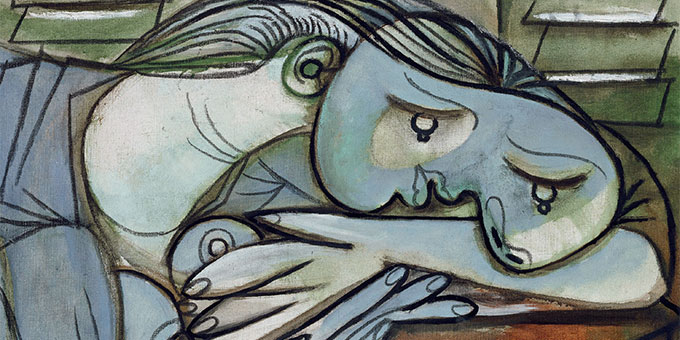Posted on August 26, 2016 in Arts & culture.
Le Rêve at the Cantini Museum in Marseille from September 17, 2016 to January 22, 2017
In the course of history, various fields of knowledge have been interested in the mysterious phenomenon of the dream trying to penetrate its secrets, to discover its hidden meaning or its function.

Pablo Picasso, Woman with shutters (detail), 1936, Paris, Musée national Picasso
Photo © RMN-Grand Palais (Musée Picasso de Paris) / Jean-Gilles Berizzi © Succession Picasso, 2016
From Antiquity, Egyptians, Greeks and Orientals, attached great importance to it and interpreted the dreams they compared to great collective myths and analyzed as a warning from the sky, omens or premonitory visions.
At the end of the XNUMXth century, many artists represented the dream as the revelation of another universe which transfigured objective reality; trying to paint the dreamlike was, for them, a way to transgress the boundaries of art, to broaden its domain and to assert its new powers. This faculty to decipher the strangeness of the soul to form imaginary representations can be considered as a metaphor for art itself.
Freud's writings, at the beginning of the XNUMXth century, on the interpretation of dreams revealed them as the privileged path to access to the unconscious, which links the subject to this vast imaginary domain. Psychoanalysis has made it possible to understand the dream considered as a surreal rebus whose laws can be deciphered. The artists then ventured to meet their inner dialogue, their fantasies, these unknown territories, constructions of the imagination, theater of symbols, which escape the constraints of reality, to represent them.
The exhibition is organized in seven sections which show the different moments of the night:
The sleep. The exhibition is a true dreamlike experience told like a dream. In the introduction to the route, the visitor crosses The Sleeping Plant (2005) by Christophe Berdaguer and Marie Péjus, then reads the watchword written in neon by Claude Lévêque: Dream! (2008). Then he falls asleep following the female figures of Odilon Redon, Auguste Rodin, Félix Vallotton, Salvador Dalí, or even Pablo Picasso.
The nocturnes. From the end of the XNUMXth century, the nocturnal representations of symbolist artists began to cross into the realm of interior reality. A Vision of Victor Hugo begins this journey to the unreal where the fantastic dream tends to the strange. The nocturnal landscapes of William Degouve de Nuncques and the luminous mists of Léon Spilliaert herald the magical realism of Paul Delvaux. A place of all imaginary possibilities, the forest becomes the border of the dream magnified by Max Ernst, a disturbing universe from which strange creatures emerge swept away by inspiration.
The dream. In 1900, the birth of psychoanalysis, then the publication of the surrealism manifesto, in 1924, offered a new iconographic repertoire to artists who ventured fully into the labyrinth of the soul. The representation of the dream frees subjectivity.
Victor Brauner reveals premonitory esoteric phenomena, Yves Tanguy escapes into the deserted expanses of thought, Salvador Dalí, inspired by Catalan beaches, paints paranoid landscapes inhabited by mythical animals, while Man Ray dreams of the lips of his muse , a strange sensual star floating above the Paris Observatory.
The fantasies. The surrealist universe is populated by diaphanous or carnal female figures, inaccessible mad loves that roam, like statues, the works of Félix Labisse or are delicately stripped under the brush of Wilhelm Freddie. Beyond "veiled eroticism", the philosophy of the Marquis de Sade wins the suggestive photographs of Hans Bellmer and the collages of Jindrich Styrsky.
The nightmare. From the "sleep of reason" illustrated by Francisco de Goya to the infernal visions of Marcel Berronneau, the artists generate frightening monsters, evil octopuses, enigmatic sphinges, hybrid snakes by Valère Bernard and other insects by Germaine Richier.
hallucination. The waking dream, dear to the surrealists in their exploratory activities of the unconscious, irrigates all forms of experimentation. Henri Michaux's mescalinian drawings, the photographs of Raymond Hains and the paintings of Aboriginal dreams are visually close to the kinetic works of Victor Vasarely. Psychedelic, the Dreamachine (1961) by Brion Gysin is the "only work of art to be looked at with closed eyes", where you fix the syncopated light of a bulb through closed eyelids, to hallucination .
Alarm clock. In a train with Bernard Plossu, on an overturned balcony in the bay of Hong Kong, according to the illusionist games of Philippe Ramette, in a room of Sandy Skoglund surrounded by floating fish or by the light of the Chinese full moon photographed by Darren Almond, the visitor wakes up to the random rhythm of Pierre Huyghe's Carillon (1997), through which everyone is invited to replay in dream the John Cage symphony Dream (1948).
Added to this is a hanging, on the 2nd floor of the museum, of cards that make up the Jeu de Marseille. This unique set which testifies to the fascination experienced by the surrealists for the field of dreams, metamorphosis and the unconscious, was offered to the City of Marseille in 2003 by Aube Elléouët-Breton (daughter of the poet) and his daughter Oona, in memory of Varian Fry.
Exhibition organized by the City of Marseille and the Meeting of National Museums - Grand Palais
commissioners : Christine Poullain, chief curator, director of the museums of Marseille
Guillaume Theulière, curator, assistant to the director of the museums of Marseille
Pratical information
opening : Tuesday to Sunday from 10 a.m. to 18 p.m. weekly closing on Mondays closed on December 25 and 26, January 1
prices : € 10, TR € 8
audio guide: 4 €
access: Cantini Museum, 19 rue Grignan, 13 006 Marseille
Metro line 1 - Estrangin / Préfecture station
information and reservations: www.grandpalais.fr - lereve.marseille.fr
Drawing Now Art Fair: Tatiana Wolska winner 2024
The invention of language by Gertrude Stein and Pablo Picasso
The history of French women's golf at Golf du Sorbier







